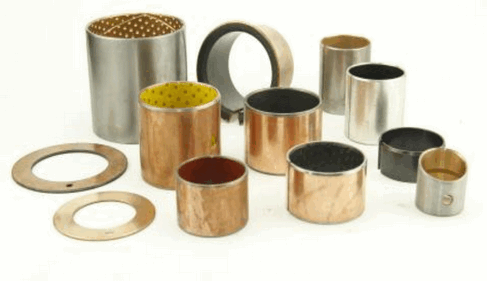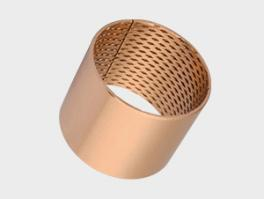Abstract: The continuous progress of science and technology has promoted the emergence and gradual application of a new type of mine hoist with rolling bearings. However, sliding bearings are still widely used in mine construction due to their more stable service life and higher transmission accuracy. However, the configuration of the sliding bearing hoist is relatively difficult, and the maintenance conditions are relatively high. Among them, the wear and failure of the sliding bearing of the hoist is one of the problems that should be focused on in coal mining. Therefore, the paper analyzes the wear failure of the elevator sliding bearing, and puts forward corresponding adjustment measures, in order to provide effective reference for the use efficiency of the elevator sliding bearing type.
Key words: elevator; Sliding bearing; Wear failure
For the coal mine hoist, the sliding bearing is the most critical component among many parts. In order to ensure the safe operation of the coal mine hoist and reduce the probability of failure, the wear and lubrication of the sliding bearing must be thoroughly analyzed to effectively reduce the repair cost and ensure the smooth progress of the coal mine mining work.
1 Overview of failure of sliding bearing of coal mine hoist
When the sliding coal mine hoist operates, the lubrication state of its sliding bearing belongs to the scope of fluid lubrication. The failure of the sliding bearing in this state usually includes the following reasons:
① The bearing pressure is too large, or the operating time is too long and the temperature is too high, resulting in the decrease of the bearing capacity of the oil film, increasing the contact friction between the journal and the bearing liner, causing serious wear damage to the bearing system and failure; ② During the production and processing of bearings, there are metal cutting residues that fall into the bearings, resulting in wear and fatigue of bearings during operation; ③ The bearing is severely worn and fails due to the over-time load operation of the bearing; ④ During operation, the clearance between the bearing and the shaft keeps getting smaller, the engagement is too tight, and the two fail due to insufficient space for movement; ⑤ Due to the ex-factory quality problem of bearings, serious wear occurred during the manufacturing process.
Generally speaking, the material of the part where the bearing has direct contact with the journal during operation is mainly set in consideration of how to reduce wear. In order to improve the service quality of the bearing and save the consumption of precious metals, a layer of material with good lubrication function will be attached to the surface of the bearing in direct contact with the journal as the lining. In view of the failure performance of the sliding bearing and its causes, the lining must have the following excellent performance:
① In dealing with friction, it has good fusion and anti-friction effect; ② In the face of high strength and long time bearing operation, the lining must have excellent fatigue resistance; ③ It can automatically hide or move out foreign solid particles to reduce the embedded degree of journal wear; ④ It can effectively reduce the friction force and thus reduce the working error of the journal during the running-in process; ⑤ Good corrosion resistance and friction resistance; ⑥ Outstanding process performance, good economic characteristics and controllable cost.
In addition, at present, tin-based babbitt alloy and lead-based babbitt alloy are mostly used in the manufacturing of bearings. These two materials have outstanding advantages in reducing friction and pressure, and are more suitable for the high-speed operation of bearings.
2 Friction and wear mechanism of elevator sliding bearing
2.1 Formation of friction and wear
The friction and wear of sliding bearing is closely related to its form. Relevant investigation data show that the bearing made of babbitt alloy material is more prone to abrasion, but there is no abrasive phenomenon. However, based on the research of relevant experiments with modern technical means, it is concluded that Babbitt alloy sliding bearings will produce a large number of abrasive particles when friction occurs. During the actual operation of the hoist, frequent starting is required. Therefore, when the sliding bearing has friction and wear and forms a dynamic oil film, it usually goes through three states: static, journal start and journal stable operation. According to the author's research on relevant literature and his own work experience for many years, the wear of the journal in the starting stage is the most obvious in these three states, and there are particles.
2.2 Wear products of elevator sliding bearing
The polymer formed after friction of babbitt alloy bearing is the bearing wear product. With the increase of time, the polymer grows from small to large. When the grain size of the abrasive particles is small, the metal content of wear can be obtained by extracting the lubricating oil being used by the hoist as the sample and using the atomic emission spectrometer for detection experiment. It is found that the content of Sn, Pb and Cu is usually high.
In view of the understanding of the lubrication and wear status of the elevator sliding bearing, it is not difficult to see that the wear rate of the bearing liner is high, and it is very easy to have operating faults. Therefore, the key to ensure the normal operation of the sliding bearing is lubrication treatment. The main role of lubricating oil is to reduce friction and improve the heat dissipation effect. The lubricating oil will also produce a large number of abrasive particles while assisting various machines and components in lubricating operation. Under the action of lubricating oil, the friction damage of bearing caused by alloy steel abrasive particles with large quantity and high hardness is greatly reduced. However, the sliding bearing in the mixed lubrication state will produce some metal abrasive particles with small particle size and uniform shape, which will be embedded into the bone bearing under the combined action of high temperature, high pressure and friction. As time goes by, the density of metal abrasive particles will become larger and larger, the friction resistance of journal and bearing will increase greatly, and plastic deformation will occur under the operation state to form a stronger friction point, resulting in the gradual reduction of the gap here until it bites, Even the bearing breaks. When the external force is greater than the combined force of the joint, the joint will undergo shear fracture. If the shear fracture is at the upper end of the bonding point, it is in zero wear state; If shear fracture occurs at low strength, material transfer will occur. Under the continuous friction in the future, the substances adhering to the journal surface gradually fall off and form abrasive particles.
2.3 Lubrication of hoist rolling bearing
According to the research, since the structure and technical parameters of coal mine hoist are usually fixed, the focus on the prevention of wear failure should be on lubrication. At present, the lubrication of the rolling shaft of many coal mine hoists is mainly carried out by means of the centralized oil supply system shared with the reducer. In this case, in order to prevent wear failure, we should determine the viscosity of the lubricating oil according to the speed and load of the rolling bearing of the coal mine hoist when it is running. For example, when the rolling bearing is running fast and bearing load is small, the viscosity value of the lubricating oil we choose should be small because of the appearance of dynamic pressure oil wedge and the relatively large displacement of the oil layer. At the same time, if the coal mine hoist often occurs reciprocating, variable speed and vibration during operation, we should select the lubricating oil with higher viscosity value in order to prevent the wear and failure of the rolling bearing. In addition, if the load on the rolling bearings of some coal mine hoists has been relatively stable, the lubricating oil should be selected with a lower viscosity value.
3 Clearance determination and ground adjustment of sliding bearing
Radial clearance and axial clearance are two main types of clearance of sliding bearing, and the former can be divided into top clearance and side clearance. The existence of radial clearance is an important guarantee for the accurate operation between the journal and the bearing, while the axial clearance is to ensure that the length of the journal can expand freely while the temperature rises.
3.1 Clearance determination
The determination of the radial clearance of the sliding bearing is usually based on the nature of the design and assembly. In general, the top clearance is twice the side clearance. The determination of the axial clearance with the sliding bearing must be combined with its specific structural form, and it should be ensured that it is greater than the longest stretch during the journal operation. Generally, the structural form should be determined according to the different structures. Generally, it should be less than 2mm, but it should also be ensured that it is more than 2mm.
3.2 Measurement and adjustment of sliding bearing clearance
The journal must be arranged at the extreme position before the clearance of the sliding bearing can be determined. The axial clearance can be obtained by using the dial indicator, feeler gauge and other relevant measurement operations, and then by superposing the data of these two extreme positions. The feeler gauge is the main measuring tool used to measure the side clearance of the sliding bearing. The measuring process should make the arc with a normal length of 30 degrees. For the measurement of the top clearance, the method of drawing the pressing lead wire with a feeler gauge can be used, but the latter is usually more accurate. It should be noted that the softer lead wire should be selected, and its radius should be kept at 2-3 times of the top clearance value, and the length should be controlled at 15mm-20mm.
3.3 Clearance adjustment
If the clearance between the top of the sliding bearing is greater than the limit value, it is necessary to weaken the adjustment of the pad mouth to ensure that the force is appropriate. At the same time, the position of the bearing journal and the lower end of the bearing should also be carefully checked and adjusted, usually to ensure that the contact angle is within 120 °.
4 Conclusion
Mine hoists are extremely important for coal mining activities, while sliding bearing hoists still occupy a very core position and are widely used. Therefore, the maintenance and repair of sliding bearing is also extremely important. Only by fully analyzing the wear and failure of the hoist sliding bearing can the normal operation of the hoist be effectively ensured in the maintenance process, and the cost of maintenance and repair be effectively reduced, and the economic benefits be improved.
More about E90 Bushing:
E90 bronze wrapped bushings are made of entirely bronze CuSn8. Because of material properties, the working surface rolled with diamond Indentations (standard Indentations) or stamped oil grooves according to detailed application. And it also has good performance of anti-corrosion caused by chemical and environments. During the operation, the grease & oil will be released from the indentations, which allow for long-term lubrication. Compare with machined bronze bearings, E90 can offer some advantages including thin wall, lower weight, cheaper cost, high load etc. It is suitable for high load, lower speed application like construction, transport, and agriculture machinery.




